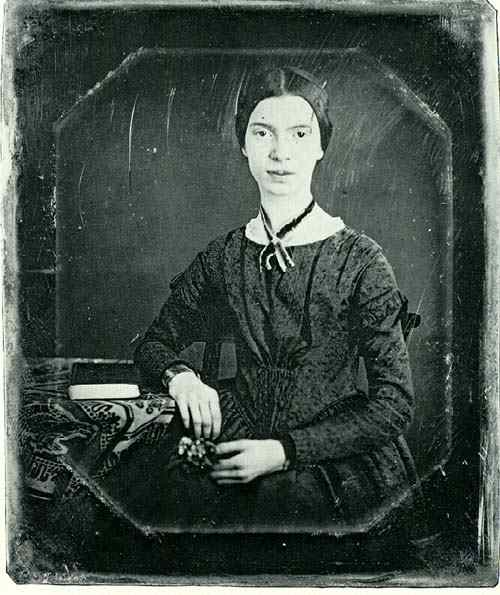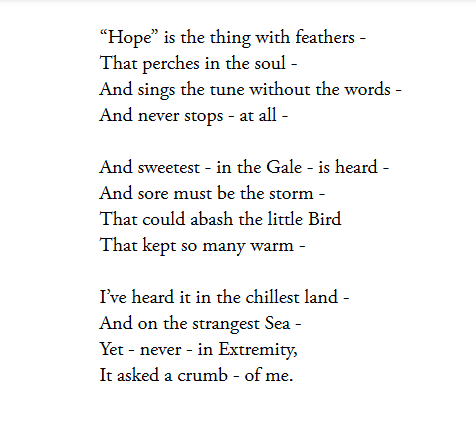Hope Poem By Emily Dickinson
Andrew has a slap-up interest in all aspects of poetry and writes extensively on the discipline. His poems are published online and in print.

Emily Dickinson
A Short Biography of Emily Dickinson
"Hope" is the thing with feathers (314) is one of the best known of Emily Dickinson's poems. As an extended metaphor, it likens the concept of promise to a feathered bird that is permanently perched in the soul of every homo. There information technology sings, never stopping in its quest to inspire.
Emily Dickinson wrote this poem in 1862, a prolific year for her verse, one of nearly ane,800 poems she penned during her lifetime. But seven of these were published while she was withal live. Her sister, Lavinia, collected and helped publish all her poems afterward Emily's death in 1886.
The Belle of Amherst, and so-chosen, remains an enigma. Her poetry was highly original merely was dismissed or misunderstood when she sent her work for appraisal or publication. It was only subsequently she had passed away and her poems circulated more widely that critics began to appreciate her genius.
Her poems, together with those of Walt Whitman, were pioneering works that pointed the way to a new and refreshing era of poetry in the English-speaking world.
Dickinson seems to have been a recluse for most of her developed life, living at the family unit home, only rarely venturing out. Tranquility and timid, she never married or actively sought a permanent relationship, despite correspondence with several older men she viewed as her protectors.
Her poetry, however, reflects a lively, imaginative and dynamic inner world; she was able to capture universal moments in a simple sentence and create metaphors that have stood the test of time.
"Hope" is the thing with feathers (314) stands out every bit a reminder to all; no matter the circumstances, each and every one of united states has this entity inside that is always at that place to assistance us out by singing.
Summary of "Hope" is the thing with feathers (314)
Total of figurative linguistic communication, this poem is an extended metaphor, transforming promise into a bird (the poet loved birds) that is ever present in the homo soul. Information technology sings, peculiarly when times get tough. Hope springs eternal, might be a reasonable summing up.
With typical disregard for convention, Emily Dickinson's odd-looking syntax has clauses interrupted past dashes, and only 1 comma throughout. This can be confusing for the reader because of the need to pause and identify extra emphasis on certain phrases.
The rhythm of the poem varies in places too, which may not be apparent on offset sighting. Readily set up to music, the words are a reminder of the poet's yearning for fulfilment in both creativity and love. And they beautifully encapsulate what promise is for us all—something that inspires and can brand the states fly.
'"Promise" is the affair with feathers (314)' by Emily Dickinson

Hope Is The Thing With Feathers
Stanza-by-Stanza Analysis of "Hope" is the thing with feathers (314)'
Emily Dickinson did not give titles to her poems, so the first line is always given every bit the title. Her poems are also given numbers. In 1998, R.W. Franklin published a definitive version of her poems, closely following the poet'south class and layout, and this poem is number 314.
Showtime Stanza
The start give-and-take is given special accent with voice communication marks (inverted commas, quotation marks) as if the poet wants to define that elusive word "Promise", and she does so with metaphor. Hope has feathers and it can, like a bird, perch in the human soul. Feathers are soft and gentle to the touch on but they are as well strong in flying, fifty-fifty on tiny birds. And feathers are fabricated up of complex individual fibres; unity is strength.
Scroll to Go along
Read More than From Owlcation
The imagery hither grows stronger as the reader progresses. Non simply is Hope feathery, it can sing. Information technology sits on a perch and sings the whole time. Just the song is special for there are no words, no diction for anyone to empathize rationally.
It's every bit if Hope is pure vocal, pure feeling, a deep seated longing that tin take flight at whatever time.
The vocal is endless. Note the double dash emphasis on—at all—and the stanza break which brings actress attention to these two lilliputian words.
2nd Stanza
The outset line is unusual in the use of the double dash—at that place are two singled-out pauses which the reader has to be careful with. Hope is ever singing as we know from the offset stanza but it sings the sweetest when the going gets rough, when the Gale starts to blow. So, when life is hard and things are thrown at us, the pressure relentless, at that place is Hope, singing through the chaos and commotion.
- Note the first mention of the bird in line 7. It would have a hellish storm to embarrass or disconcert this bird (sore—angry and abash—embarrass) which protects many people from adverse situations. Promise is difficult to disturb, even when life seems hard.
Third Stanza
The personal pronoun I appears for the first time, indicating a personal connection to this subject peradventure? Emily Dickinson thought of herself equally a fiddling bird (a wren) and then the link is straight.
The speaker has heard the bird during the hardest, coldest times, when emotions are churning and life surreal. Simply even when things are extreme Hope is even so there and never asks for anything.
Promise gives us much simply never asks for a crumb in return. It is all inspirational, yet slightly mysterious. Hope wells up in the heart and soul yet who knows where it comes from?
Philosophy, religion, psychology and even metaphor are not sufficient—there is an abstract nature to Hope. It can give united states of america strength to carry on in the almost adverse of conditions. Its voice can be heard, despite the noise at the height of the storm.
Further Analysis
'"Promise" is the thing with feathers (314)' is a short verse form with three stanzas, each one a quatrain.
Rhyme
The rhyme scheme is abcb, the second and fourth lines rhyme full except for the half rhyme in the outset stanza, soul/all.
- 2nd stanza—annotation the additional full rhyme of lines 1 and 3 (heard/bird) which helps tighten the mid section of the poem and places emphasis on the bird's ability to sing sweeter.
Syntax
Emily Dickinson used a lot of dashes in her poetry and this verse form has a total of 15, which creates unusual syntax—the fashion the clauses fit together with punctuation, meter (metre in Britain) and enjambment.
- It'southward as if, for every breath she took whilst creating and reading through her lines, she wrote a nuance, instead of, say, a comma. In addition, certain phrases are enclosed in a separate double dash, which places particular emphasis on meaning. Note: - at all - in the outset stanza, and -in the Gale - in the second, plus - never - in the final stanza.
What Is the Meter in '"Hope" is the matter with feathers (314)'?
Every bit with many of Emily Dickinson's poems, this i follows a basic iambic trimeter rhythm, with an extra syllable in the first and 3rd lines of each stanza.
But there are lines that exercise not suit to the iambic beat.
Hope is / the thing / with feathers—and so nosotros take an opening trochee followed by two iambs and extra crush or feminine ending. Emphasis when reading falls on the opening word.
That per / ches in / the soul— Iambic trimeter continues in the second line.
I've heard / information technology in / the chill / est country— the 9th line could be scanned as iambic tetrameter.
Yet - nev / er - in / Extre / mity, note spondee, pyrrhic and two iambs in line 11.
Sources
- Norton Anthology, Norton, 2005
- Library of Congress
- The Poetry Handbook, John Lennard, OUP, 2005
© 2017 Andrew Spacey
Hope Poem By Emily Dickinson,
Source: https://owlcation.com/humanities/Analysis-of-Poem-Hope-Is-The-Thing-With-Feathers-by-Emily-Dickinson
Posted by: starnerserroustere.blogspot.com


0 Response to "Hope Poem By Emily Dickinson"
Post a Comment